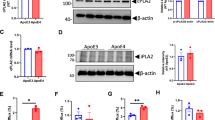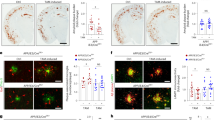Abstract
Chronically activated glia associated with amyloid plaques might contribute to neuronal dysfunction in Alzheimer’s disease (AD) through generation of neuroinflammatory molecules. Apolipoprotein E (apoE), also found associated with amyloid plaques, has been hypothesized to serve an anti-inflammatory role in the CNS through its ability to modulate β-amyloid (Aβ)-induced glial activation. To further characterize the effect of apoE on inflammation, we examined the ability of exogenously added human apoE3 and apoE4 to modulate neuroinflammatory responses of cultured rat glia. Apolipoprotein E3 (apoE3) and apoE4 suppressed oligomeric Aβ-induced production of inducible nitric oxide synthase and cyclo-oxygenase-2, supporting an anti-inflammatory role for apoE. Exogenous apoE also inhibited Aβ-induced production of endogenous apoE. However, exogenous apoE in the absence of Aβ stimulated production of the pro-inflammatory cytokine interleukin-1β in an isoform-dependent manner, with apoE4 inducing a significantly greater response than apoE3. These data support the idea that Aβ stimulation of glial apoE limits neuroinflammation but that overproduction of apoE by activated glia might exacerbate inflammation. In addition, the observation that apoE4 has more robust pro-inflammatory activity than apoE3 provides a mechanistic link between the APOE4 allele and AD, and suggests potential apoE-based therapeutic strategies.
Similar content being viewed by others
References
Akiyama H., Barger S., Barnu, S., Bradt B., Bauer J., Cole G. M., et al. (2000) Inflammation and Alzheimer’s disease. Neurobiol. Aging 21, 383–421.
Bales K. R., Dodart J. C., DeMattos R. B., Holtzman D. M., and Paul S.M. (2002) Apolipoprotein E, amyloid, and Alzheimer disease. Mol. Interventions 2, 363–375.
Bales K. R., Verina T., Cummins D. J., Du Y., Dodel R. C., Saura J., et al. (1999) Apolipoprotein E is essential for amyloid deposition in the APPV717F transgenic mouse model of Alzheimer’s disease. Proc. Natl. Acad. Sci. USA 96, 15233–15238.
Barger S. W. and Harmon A. D. (1997) Microglial activation by Alzheimer amyloid precursor protein and modulation by apolipoprotein E. Nature 388, 878–881.
Beffert U., Danik M., Krzywkowski P., Ramassamy C., Berrada F., and Poirier J. (1998) The neurobiology of apolipoproteins and their receptors in the CNS and Alzheimer’s disease. Brain Res. Rev. 27, 119–142.
Clay M. A., Ananthraramaiah G. M., Mistry M. J., Balasubramaniam A., and Harmony J. A. K. (1995) Localization of a domain in apolipoprotein E with both cytostatic and cytotoxic activity. Biochemistry 34, 11142–11151.
Colton C. A., Brown C. M., Czapiga M., and Vitek M. P. (2002) Apolipoprotein E allele specific regulation of nitric oxide production. Ann. N. Y. Acad. Sci. 962, 212–225.
Dahlgren K. N., Manelli A. M., Stine W. B., Baker L. K., Krafft G. A., and LaDu M. J. (2002) Oligomeric and fibrillar species of amyloid-β peptides differentially affect neuronal viability. J. Biol. Chem. 277, 32046–32053.
Gotthardt M., Trommsdorff M., Nevitt M. F., Shelton J., Richardson J. A., Stockinger W., et al. (2000) Interactions of the low density lipoprotein receptor gene family with cytosolic adaptor and scaffold proteins suggest diverse biological functions in cellular communication and signal transduction. J. Biol. Chem. 275, 25616–25624.
Griffin W. S. T., Sheng J. G., Royston M. C., Gentleman S. M., McKenzie J. E., Graham D. I., et al. (1998) Glial-neuronal interactions in Alzheimer’s disease: the potential role of a “cytokine cycle” in disease progression. Brain Pathol. 8, 65–72.
Holtzman D. M., Bales K. R., Tenkova T., Fagan A. M., Parsadanian M., Sartorius L. J., et al. (2000) Apolipoprotein E isoform-dependent amyloid deposition and neuritic degeneration in a mouse model of Alzheimer’s disease. Proc. Natl. Acad. Sci. USA 97, 2892–2897.
Hu J., Castets F., Guevara J. L., and Van Eldik L. J. (1996) S100β stimulates inducible nitric oxide synthase activity and mRNA levels in rat cortical astrocytes. J. Biol. Chem. 271, 2543–2547.
Hu J., LaDu M. J., and Van Eldik L. J. (1998) Apolipoprotein E attenuates β-amyloid-induced astrocyte activation. J. Neurochem. 71, 1626–1634.
Hyman B. T., Strickland D., and Rebeck G. W. (2000) Role of the low-density lipoprotein receptor-related protein in β-amyloid metabolism and Alzheimer disease. Arch. Neurol. 57, 646–650.
Janciauskiene S., Sun Y. X., and Wright H. T. (2002) Interactions of Aβ with endogenous anti-inflammatory agents: a basis for chronic neuroinflammation in Alzheimer’s disease. Neurobiol. Dis. 10, 187–200.
LaDu M. J., Falduto M. T., Manelli A. M., Reardon C. A., Getz G. S., and Frail D. E. (1994) isoform-specific binding of apolipoprotein E to β-amyloid. J. Biol. Chem. 269, 23403–23406.
LaDu M.J., Reardon C., Van Eldik L. J., Fagan A. M., Bu G., Holtzman D., and Getz G. S. (2000a) Lipoproteins in the central nervous system. Ann. N. Y. Acad. Sci. 903, 167–175.
LaDu M. J., Shah J. A., Reardon C. A., Getz G. S., Bu G., Hu J., et al. (2000b) Apolipoprotein E receptors mediate the effects of β-amyloid on astrocyte cultures. J. Biol. Chem. 275, 33974–33980.
LaDu M. J., Shah J. A., Reardon C. A., Getz G. S., Bu G., Hu J., et al. (2001) Apolipoprotein E and apolipoprotein E receptors modulate Aβ-induced glial neuroinflammatory responses. Neurochem. Int. 39, 427–434.
Laskowitz D. T., Goel S., Bennett E. R., and Matthew W. D. (1997) Apolipoprotein E suppresses glial cell secretion of TNFα. J. Neuroimmunol. 76, 70–74.
Laskowitz D. T., Thekdi A. D., Thekdi S. D., Han S. K. D., Myers J. K., Pizzo S. V., and Bennett E. R. (2001) Downregulation of microglial activation by apolipoprotein E and apoE-mimetic peptides. Exp. Neurol. 167, 74–85.
Lynch J. R., Morgan D., Mance J., Matthew W. D., and Laskowitz D. T. (2001) Apolipoprotein E modulates glial activation and the endogenous central nervous system inflammatory response. J. Neuroimmunol. 114, 107–113.
Mahley R. W. and Rall S. C. Jr. (2000) Apolipoprotein E: far more than a lipid transport protein. Annu. Rev. Genomics Hum. Genet. 1, 507–537.
Manelli A. M., Stine W. B. Jr., Van Eldik L. J., and LaDu M. J. (2004) ApoE and Aβ1-42 interactions: effects of isoform and conformation on structure and function. J. Mol. Neurosci. 23, 231–242.
Moulder K. L., Narita M., Chang L. K., Bu G., and Johnson E. M. Jr. (1999) Analysis of a novel mechanism of neuronal toxicity produced by an apolipoprotein E-derived peptide. J. Neurochem. 72, 1069–1080.
Mrak R. E. and Griffin W. S. T. (2001) Interleukin-1, neuroinflammation, and Alzheimer’s disease. Neurobiol. Aging 22, 903–908.
Petrova T. V., Akama K. T., and Van Eldik L. J. (1999) Cyclopentanone prostaglandins suppress activation of microglia: down-regulation of inducible nitric oxide synthase by 15-deoxy-δ12,14-prostaglandin J2. Proc. Natl. Acad. Sci. USA 96, 4668–4673.
Qiao X., Cummins D. J., and Paul S. M. (2001) Neuroinflammation-induced acceleration of amyloid deposition in the APPV717F transgenic mouse. Eur. J. Neurosci. 14, 474–482.
Tokuda T., Calero M., Matsubara E., Vidal R., Kumar A., Permanne B., et al. (2000) Lipidation of apolipoprotein E influences its isoform-specific interaction with Alzheimer’s amyloid β peptides. Biochem. J. 348, 359–365.
Tolar M., Keller J. N., Chan S., Mattson M. P., Marques M. A., and Crutcher K. A. (1999) Truncated apolipoprotein E (ApoE) causes increased intracellular calcium and may mediate ApoE neurotoxicity. J. Neurosci. 19, 7100–7110.
Tolar M., Marques M. A., Harmony J. A., and Crutcher K. A. (1997) Neurotoxicity of the 22 kDa thrombin-cleavage fragment of apolipoprotein E and related synthetic peptides is receptor-mediated. J. Neurosci. 17, 5678–5686.
Van Eldik L. J. (2001) Glia and Alzheimer’s disease. Neurochem. Int. 39, 329–331.
Wyss-Coray T. and Nucke L. (2000) Inflammation in neurodegenerative disease—a double-edged sword. Neuron 35, 419–432.
Author information
Authors and Affiliations
Corresponding author
Rights and permissions
About this article
Cite this article
Guo, L., LaDu, M.J. & Van Eldik, L.J. A dual role for apolipoprotein E in neuroinflammation. J Mol Neurosci 23, 205–212 (2004). https://doi.org/10.1385/JMN:23:3:205
Received:
Accepted:
Issue Date:
DOI: https://doi.org/10.1385/JMN:23:3:205




